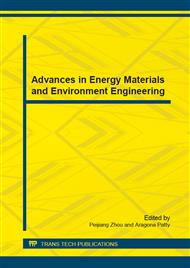[1]
C. Lors, J. -F. Ponge, M.M. Aldaya and D. Damidot: Comparison of solid-phase bioassays and ecoscores to evaluate the toxicity of contaminated soils. Environ. Pollut., Vol. 158 (2010), pp.2640-2647.
DOI: 10.1016/j.envpol.2010.05.005
Google Scholar
[2]
H. Raclavska, S. Doskarova and H. Skrobankova: Ecotoxicity of sewage sludge from waste water treatment plant. Inzynieria Mineralna, Vol. 27 (2011), pp.39-50.
Google Scholar
[3]
Z. Dolnicek, K. Kropac, P. Uher and M. Polach: Mineralogical and geochemical evidence for multi-stage origin of mineral veins hosted by teschenites at Tichá, Outer Western Carpathians, Czech Republic. Chem. Erde, Vol. 70 (2010), pp.267-282.
DOI: 10.1016/j.chemer.2010.03.003
Google Scholar
[4]
R. Wlodyka and L. Karwowski: A mesozoic volcanic rock series in the Polish Western Carpathians. Pol. Tow. Mineral., Pr. Spec. 22 (2003), pp.248-255.
Google Scholar
[5]
M. Ahmad, A.U. Rajapaksha, J.E. Lim, M. Zhang, N. Bolan, D. Mohan, M. Vithanage, S.S. Lee and Y.S. Ok: Biochar as a sorbent for contaminant management in soil and water: A review. Chemosphere, Vol. 99 (2014), pp.19-33.
DOI: 10.1016/j.chemosphere.2013.10.071
Google Scholar
[6]
E.E.V. Chapman, G. Dave and J. D. Murimboh: A review of metal (Pb and Zn) sensitive and pH tolerant bioassay organisms for risk screening of metal-contaminated acidic soils. Environ. Pollut., Vol. 179 (2013), pp.326-342.
DOI: 10.1016/j.envpol.2013.04.027
Google Scholar
[7]
J. Tang, W. Zhu, R. Kookana and A. Katayama: Characteristics of biochar and its application in remediation of contaminated soil. J. Biosci. Bioeng., Vol. 116 (2013), pp.653-659.
DOI: 10.1016/j.jbiosc.2013.05.035
Google Scholar
[8]
M. Meli, A. Auclerc, A. Palmqvist, V.E. Forbes and V. Grimm: Population-level consequences of spatially heterogeneous exposure to heavy metals in soil: An individual-based model of springtails. Ecol. Modell., Vol. 250 (2013), pp.338-351.
DOI: 10.1016/j.ecolmodel.2012.11.010
Google Scholar
[9]
K. Lock and C.R. Janssen: Ecotoxicity of Chromium (III) to Eisenia fetida, Enchytraeus albidus, and Folsomia candida. Ecotoxicol. Environ. Saf., Vol. 51 (2002), pp.203-205.
DOI: 10.1006/eesa.2001.2122
Google Scholar
[10]
J. Lehmann, M.C. Rillig, J. Thies, C.A. Masiello, W.C. Hockaday and D. Crowley: Biochar effects on soil biota - A review. Soil Biol. Biochem., Vol. 43 (2011), pp.1812-1836.
DOI: 10.1016/j.soilbio.2011.04.022
Google Scholar
[11]
W. Didden and J. Römbke: Enchytraeids as indicator organisms for chemical stress in terrestrial ecosystems. Ecotoxicol. Environ. Saf., Vol. 50 (2001), pp.25-43.
DOI: 10.1006/eesa.2001.2075
Google Scholar
[12]
J. Frouz, K. Hrckova, J. Lana, V. Kristufek, O. Mudrak, A. Lukesova and M. Mihaljevic: Can laboratory toxicity tests explain the pattern of field communities of algae, plants, and invertebrates along a toxicity gradient of post-mining sites? Applied Soil Ecology, Vol. 51 (2011).
DOI: 10.1016/j.apsoil.2011.09.007
Google Scholar
[13]
M.T. Fountain and S.P. Hopkin: Folsomia candida (Collembolla): a"standard" soil arthropod. Annu. Rev. Entomol., Vol. 50 (2005), pp.201-222.
DOI: 10.1146/annurev.ento.50.071803.130331
Google Scholar
[14]
E.A.N. Marks, S. Mattana, J.M. Alcaniz and X. Domene: Biochars provoke diverse soil mesofauna reproductive responses in laboratory bioassays. Eur. J. Soil Biol., Vol. 60 (2014), pp.104-111.
DOI: 10.1016/j.ejsobi.2013.12.002
Google Scholar


